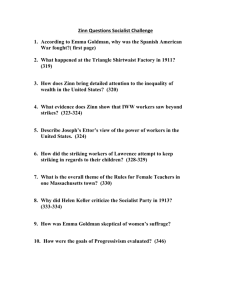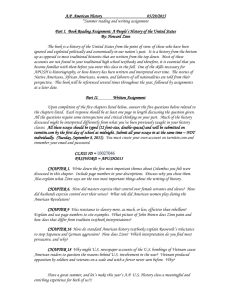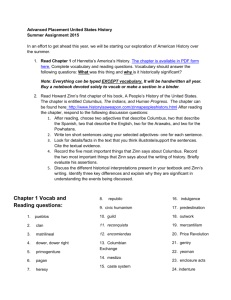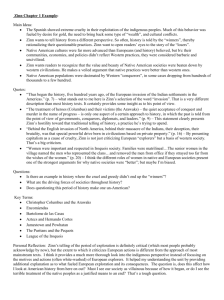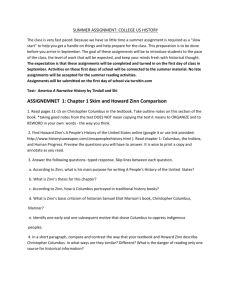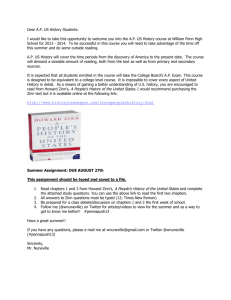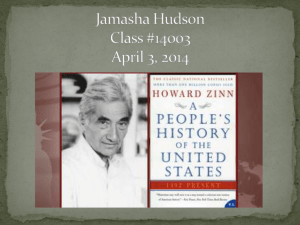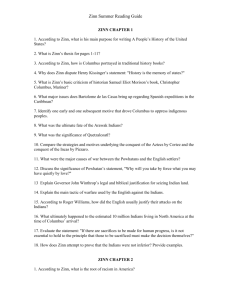Zinn's A People's History Study Questions
advertisement
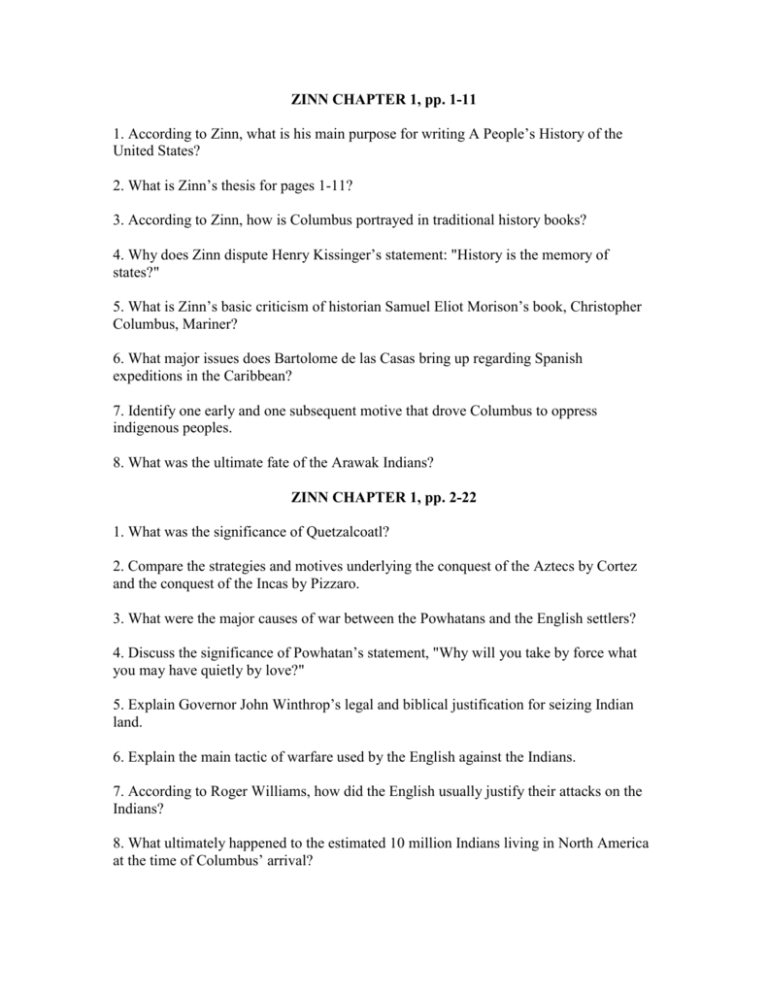
ZINN CHAPTER 1, pp. 1-11 1. According to Zinn, what is his main purpose for writing A People’s History of the United States? 2. What is Zinn’s thesis for pages 1-11? 3. According to Zinn, how is Columbus portrayed in traditional history books? 4. Why does Zinn dispute Henry Kissinger’s statement: "History is the memory of states?" 5. What is Zinn’s basic criticism of historian Samuel Eliot Morison’s book, Christopher Columbus, Mariner? 6. What major issues does Bartolome de las Casas bring up regarding Spanish expeditions in the Caribbean? 7. Identify one early and one subsequent motive that drove Columbus to oppress indigenous peoples. 8. What was the ultimate fate of the Arawak Indians? ZINN CHAPTER 1, pp. 2-22 1. What was the significance of Quetzalcoatl? 2. Compare the strategies and motives underlying the conquest of the Aztecs by Cortez and the conquest of the Incas by Pizzaro. 3. What were the major causes of war between the Powhatans and the English settlers? 4. Discuss the significance of Powhatan’s statement, "Why will you take by force what you may have quietly by love?" 5. Explain Governor John Winthrop’s legal and biblical justification for seizing Indian land. 6. Explain the main tactic of warfare used by the English against the Indians. 7. According to Roger Williams, how did the English usually justify their attacks on the Indians? 8. What ultimately happened to the estimated 10 million Indians living in North America at the time of Columbus’ arrival? 9. Evaluate the statement: "If there are sacrifices to be made for human progress, is it not essential to hold to the principle that those to be sacrificed must make the decision themselves?" 10. How does Zinn attempt to prove that the Indians were not inferior? Provide examples. ZINN CHAPTER 2 Study Questions 1. According to Zinn, what is the root of racism in America? 2. Why were Africans considered "better" slaves than Indians in Virginia? 3. How did 16th century Africa compare to 16th century Europe politically, economically, and militarily? 4. How did slavery in Africa differ from slavery in Europe and the Americas? 5. Describe the conditions that slaves on ships coming to America ("Middle Passage"). 6. What was the position of the Catholic church in Portugal vis-à-vis slavery? 7. In terms of mortality, what was the cost of slavery? 8. What was the relationship between slavery and the plantation system. 9. What evidence exists that America’s slaves did not accept their fate easily? 10. Why did slave owners fear poor whites? ZINN CHAPTER 3 Study Questions 1. What is Zinn’s thesis in this chapter? 2. What was the underlying cause of Bacon’s Rebellion? 3. What was the "double motive" of the Virginia government vis-à-vis Bacon’s Rebellion? 4. What groups of people took part in Bacon’s Rebellion? 5. Explain indentured servitude (also known as the "headright system"). 6. How did the voyage of indentured servants to America compare with the "Middle Passage." 7. What generally happened to indentured servants after they became free? 8. To what extent did a class structure emerge in America by 1700? 9. What evidence does Zinn provide regarding the monopoly of power by the rich in Boston? 10. Explain the statement: "The country therefore was not "born free" but born slave and free, servant and master, tenant and landlord, poor and rich." 11. How did the rich manage to keep Indians "at a distance?" 12. What was the probable reason why Parliament made transportation to the New World a legal punishment for crime? 13. Explain the statement: "race was becoming more and more practical." ZINN CHAPTER 4 Study Questions 1. What is the thesis of this chapter? 2. According to Zinn, how did the creation of the United States benefit the upper class? 3. Describe the disproportionate distribution of wealth in Boston, Philadelphia, and New York. 4. Why were both Loyalists and leaders of the Revolution concerned about the lower classes in Philadelphia. 5. What major issues fueled the Regulator movement? 6. What was General Gage’s observation vis-à-vis/regarding the leaders of the movement against the Stamp Act? 7. What advice did colonial leaders including -- Samuel Adams and James Otis -- give to the people concerning the Townshend Acts? 8. What class did the leaders of the Sons of Liberty come from? What was their goal? 9. What was the significance of Patrick Henry’s oratory? 10. What was one of John Adam’s concerns vis-à-vis Thomas Paine’s Common Sense? 11. According to Zinn, who does Paine really represent? 12. What groups of Americans were deprived of the ideals set forth in the Declaration of Independence? 13. What is the irony Zinn tries to convey concerning John Locke? 14. Explain the statement: "Tyranny is Tyranny, let it come from whom it may." ZINN CHAPTER 5: Part I -- pp. 76-88 Study Questions 1. What support did the Revolutionary War effort have among the colonial population? 2. What impact did slavery have on the war effort in the South? 3. What incentives did the Revolutionary War leaders use to attract recruits? 4. What was the American Navy’s position vis-à-vis impressment? 5. Why did Robert Morris’ plan to assuage the concerns of financial contributors to the Continental Congress anger the common soldier? 6. What was the British strategy concerning slavery in the South? 7. How is the general perception that the Revolution engendered the separation of church and state challenged by Zinn? 8. How did land confiscated from Loyalists reflect the Revolution’s effect on class relations? 9. How does Edmund S. Morgan’s summary of the class nature of the Revolution challenge the popular perception of the Revolution and its ideals? How does Richard Morris’ statement also challenge popular perception? 10. Explain Carl Degler’s assertion that "no new social class came to power throughout the door of the American revolution." 11. What was the impact of America’s victory on the Native Americans? 12. Explain Jennings’ statement: The Revolution was a "multiplicity of variously oppressed and exploited peoples who preyed upon each other." ZINN CHAPTER 5: Part II -- pp. 88-101 Study Questions 1. What is Charles Beard’s thesis in An Economic Interpretation of the Constitution visà-vis the Founding Fathers and the creation of the Constitution? 2. What was the source of resentment in western towns of Massachusetts against the legislature in Boston? 3. How did disgruntled western farmers seek to improve their shaky economic situation? 4. What was Daniel Shays’s objective? 5. What was Thomas Jefferson’s view of popular uprisings? Contrast his view with those of the established leadership. 6. Why does Zinn state that democracy’s problem in post-Revolutionary America was not primarily due to Constitutional limitations on voting? 7. How is Zinn critical of Madison’s argument in Federalist X. 8. Why does Zinn assert that despite party differences among Federalists and Democratic-Republicans they were both fundamentally similar? 9. How does Zinn characterize the Constitution’s compromises? 10. How does Zinn refute one of Beard’s critics, Robert E. Brown? 11. How does the Constitution illustrate the complexity of the American system? 12. How does the Constitution’s contract clause or tax clause favor rich over poor? 13. How does Zinn argue the First Amendment is not as stable as one might assume? 14. How does Zinn contrast the government’s enforcement of the First Amendment and the power to tax? 15. How does Zinn refute Bernard Bailyn’s view of the creation of the Constitution. ZINN CHAPTER 6: STUDY QUESTIONS "The Intimately Oppressed" 1. What is the theme of the reading? 2. How does treatment of women differ between societies based on private property and those based on communal living? Why? 3. How did the earliest female settlers in Virginia fare? 4. How were women treated on the frontier compared to those living in towns or cities? 5. How did English law affect the status of women in America? 6. How does Zinn use the case of Ann Hutchinson to support his basic argument? 7. How did the American Revolution affect women? 8. Explain the position of Abigail Adams vis-à-vis the role of women in America. 9. What social forces led to the onset of the "cult of true womanhood" or the "cult of domesticity?" Describe the woman’s role in this philosophy. 10. How was dress used as a means of social control? 11. What rights were denied women in the "cult of true womanhood?" 12. How did workers’ strikes in the 1830s and 1840s reflect the changing role of women? 13.What is the connection between primary school teaching and women’s participation in reform movement of the 1830s, 1840s and 1850s? 14. Create a table for the women reformers discussed in the reading. (Note: you can do yourself a big favor by also including those female reformers Bailey mentions in order to create a comprehensive study list). ZINN CHAPTER 7: Study Questions "As Long as Grass Grows or Water Runs" 1. What is the major theme (recurring idea) in this chapter. 2. What evidence does Zinn cite to illustrate the overall impact of Indian removal? 3. Contrast Thomas Jefferson’s views as Secretary of State concerning Indian policy with those during his presidency. Why did his views change? 4. Explain Zinn’s use of irony when describing the Battle of Horseshoe Bend? 5. How does Andrew Jackson’s early political/military career foreshadow his Indian policies as President? 6. How does Zinn’s view of the War of 1812 contrast with traditional histories? 7. Create a basic outline of Jackson’s Indian-related activities and their significance prior to his presidency (treaties, land speculation, etc.) 8. Explain Zinn’s view of Arthur Schlesinger’s The Age of Jackson and Marvin Meyers’ The Jacksonian Persuasion. 9. Describe evidence Zinn utilizes to assess the views of Lewis Cass vis-à-vis Native American policy. 10. Create a table illustrating the fate of major Southeastern Indian tribes. 11. To what extent did the Cherokee nation change its culture in order to survive within the U.S? 12. For what purpose does Zinn juxtapose the Nullification Controversy of 1832 and the enforcement of Worcester v. Georgia? 13. Explain the significance of the phrase: "As long as grass grows or water runs." ZINN CHAPTER 8: Study Questions "We Take Nothing by Conquest, Thank God" 1. Identify the thesis or theme in this chapter. 2. How did the U.S. use the Texas-Mexico border dispute to its advantage? 3. Explain the term "Manifest Destiny" and its implications on U.S. foreign policy in the 1840s. 4. Explain the Whig position vis-à-vis the Mexican War. 5. How does Zinn portray Abraham Lincoln’s position? 6. How does the U.S. philosophically justify its aggression? 7. What evidence does Zinn utilize to illustrate American opposition to the Mexican War? 8. How does Zinn use the ethnic composition of the U.S. army to reinforce his argument? 9. How does Zinn characterize the morale of U.S. soldiers after the initial stages of the conflict? Provide evidence cited throughout the chapter for why soldiers came to feel the way they did. 10. Explain the statement: "It was a war of the American elite against the Mexican elite, each side exhorting, using, killing its own population as well as the other." 11. Provide evidence of how the Mexican population was affected by the war. 12. How did veterans fare economically after they came home from the war? 13. Discuss how Zinn uses the phrase "We take nothing by conquest, thank God" to buttress his argument. ZINN CHAPTER 9: PART I -- pp. 167-179 Study Questions 1. To what extent was the termination of the slave trade in 1808 enforced? Why? 2. Explain the statement: "Are the conditions of slavery as important as the existence of slavery? 3. What evidence does Zinn include to prove the existence of slave revolts in the United States? 4. Analyze the impact of Nat Turner’s rebellion on Southern thought. 5. Explain the phrase: Among slaves there was "simultaneous accommodation and resistance to slavery." Provide examples to support your explanation. 6. To what extent was the Underground Railroad successful? Provide evidence. 7. How were poor whites utilized by plantation owners to maintain control? 8. Explain the use of religion as a means of control. 9. To what extent did slaves maintain their sense of culture, community, and kinship? 10. Explain the significance of David Walker. 11. Explain the significance of Frederick Douglass. 12. What was the basic message of Douglass’ Independence Day address in July, 1852? 13. Contrast the abolitionist views of Frederick Douglass and William Lloyd Garrison. How did they generally represent black and white abolitionist views? ZINN CHAPTER 9: PART II -- pp. 180-192 Study Questions 1. How does Zinn justify that black abolitionists were the "backbone of the antislavery movement." 2. How does W.E.B. Du Bois characterize John Brown and his attack on Harper’s Ferry? 3. For what reasons does Zinn criticize the national government when discussing Brown’s execution? 4. Overall, how does Zinn characterize Lincoln? Provide examples. 5. Discuss the legal provisions of the Emancipation Proclamation (i.e., what did it do and what didn’t it do?). 6. Explain Hofstadter’s statement: The Emancipation Proclamation "had all the moral grandeur of a bill of lading." 7. What significance did the Emancipation Proclamation have on the war’s outcome? 8. What caused draft riots in 1863? 9. As the Civil War wore on, how did the South respond vis-à-vis slaves? 10. How did black women play an important part in the war? 11. In general, what position did most slaves take during the war? 12. How did the treatment of blacks in the Union army and northern cities foreshadow the limitations of emancipation? ZINN CHAPTER 9: PART III -- pp. 192-205 Study Questions 1. What did the U.S. government do with abandoned plantations in the fallen Confederacy? 2. Analyze the statement: "The American government had set out to fight the slave states in 1861, not to end slavery, but to retain the enormous national territory and market and resources. 3. What political conditions existed that provided for the passage of the 13th, 14th, and 15th Amendments? 4. Explain the significance of the "black codes." 5. To what extent did blacks assert their freedom in the years immediately following the Civil War? Provide evidence. 6. How does Zinn defend the increase in South Carolina’s debt? 7. In what ways did the white Southern leadership use its power to deny rights of African Americans? 8. What role did the Supreme Court play with regard to African American rights in the years following the Civil War? Provide evidence. 9. Who was John Harlan and what were his views concerning the Supreme Court decisions that deprived blacks their rights? 10. In what ways did the South look to the national government for help? 11. Explain the significance of the election of 1876 on in the South. 12. How does Zinn justify the actions of Booker T. Washington? 13. To what extent did the conditions for African Americans in the post-Civil War South lead to migration? 14. How did W.E.B. Du Bois view the exploitation of blacks as part of a larger trend in the U.S.? Zinn, Ch. 11 Quiz 1. What did SUCCESS mean in America? 2. Who pays the cost of capitalism: the individual or the whole society? 3. Who reaps the benefits? 4. Do the benefits negate the prices? 5. Has the American definition of SUCCESS changed since Carnegie’s time? Who pays the price for success today? 6. Are we any better at balancing individual freedoms and the collective good than leaders of government/society in the Gilded Age? Zinn Chapter 14 Quiz 1. Explain the process by which the United States entered “the fateful union of war and prosperity.” Consider for discussion the purpose of “war.” Be specific. 2. Analyze the effects of the Espionage Act of 1917 on dissent in the Unites States during WWI. Use specific examples in the reading of the federal government’s efforts to quell resistance and opposition to the war. Zinn Ch. 16 Reading Quiz 1) How does the US government’s “record in world affairs” prior to 1941 indicate that US involvement in WWII promised not to be effective blow to “imperialism, racism, totalitarianism, militarism, in the world?” 2) How does Zinn explain Roosevelt’s failure to “take steps” that might have saved thousands of people from dying in Nazi concentration camps? 3) If the atomic bombing of Hiroshima and Nagasaki was not necessary to force Japan to surrender, why was it done? 4) Is the rationale for American involvement in the Korean War contradicted by its actions during the war? Why? 5) Why did US foreign policy support right-wing dictatorships? Chapter 12: The Empire and the People 155. What was officially closed in 1890? What also happened that year? 156. What was the purpose of the Monroe Doctrine? 157. What had Captain Mahan advocate? 158. What were reasons for imperialism? Reasons against? 159. Describe the “Splendid Little War” 160. How did Anti-Imperialists hope that the Teller Amendment would change US policy? 161. What was the Platt Amendment? 162. What territories did the US gain from the Spanish-American War/ 163. What problem(s) did the Philippines present? Chapter 13: The Socialist Challenge 164. Who were the major writers in the early twentieth century who supported socialism? 165. Who were “muckrakers”? 166. Who was/significance of Ida Tarbell and Lincoln Steffens? Advanced Placement United States History--2010 Summer Reading Assignment AIS/Independence High School 6 | P a g e “History is a guide to navigation in perilous times. History is who we are and why we are the way we are.” --David McCullough 167. What was Taylorism? 168. What did the Triangle Shirtwaist Company fire inspire? 169. Describe the rise of the IWW’s and their leaders. 170. How did the Socialist movement connect to the women’s suffrage movement? 171. How were the “Progressive” reforms just fitting in to maintain the “status quo”? 172. How was Colorado a scene of class conflict? Chapter 14: War Is the Health of the State 173. Explain “War is the health of the state.” 174. Why did US sympathy turn towards helping the Allies and against the Central powers? 175. Explain how Bernard Baruch’s War Industries board became so powerful. 176. What did W.E.B Dubois argue about World War I? 177. Why was the Espionage Act passed? 178. Who was Jeannette Rankin and her importance? 179. What did the explosion in front of Attorney General A. Mitchell Palmer spark? 180. What was the controversy around the Sacco and Vanzetti trial? Chapter 15: Self-help in Hard Times 181. How did Congress restrict immigration? 182. What reached the height of its membership? 183. What did Marcus Garvey preach? 184. Where was the majority of the wealth concentrated? 185. What had women finally gained? 186. What was the Mellon Plan? 187. How did the Great Depression happen? 188. What was the Bonus Army? 189. How did FDR win the election? 190. What were his first two pressing objectives? 191. How was FDR’s plan fitting in to the established condition (control by the wealthy) rather than giving the power back to the people (according to Zinn)? 192. What happened to the Scottsboro boys? 193. What was the Committee for Industrial Organization? Who led them? 194. How did the New Deal contribute to the rise of the African American Civil Rights movement? Chapter 16: A People’s War? 195. Of what was World War II the first? 196. What brought the US into the war? 197. What did the Tokyo War Crimes Trial argue? 198. What were the goals of the Atlantic Charter? 199. What organizations did the US and the UK establish to ensure that they would be on top once the war was over? 200. What argument does Zinn make that US was very similar to the Fascist Germany during World War II? 201. What controversial argument does Zinn make about the bombings of Hiroshima and Nagasaki? 202. How did the US use the Cold War to continue to contain the masses? 203. What was the purpose of the Truman Doctrine? 204. What was the purpose of Executive Order 9835? 205. Zinn makes the argument that it wasn’t just Soviet expansion that worried the US. What does he say was worrying about China, Korea, Indochina, and the Philippines? 206. Who was Senator Joseph McCarthy and his role? 207. How did the United States get involved in Cuba (again) Chapter 17: Or Does it Explode? 208. Describe the mood of the poems Zinn includes. Advanced Placement United States History--2010 Summer Reading Assignment AIS/Independence High School 7 | P a g e “History is a guide to navigation in perilous times. History is who we are and why we are the way we are.” --David McCullough 209. Why did the US feel that small steps would be justified? 210. What did Truman do to the army? 211. Why was 1954 a significant year for the Civil Rights Movement? 212. How did Rosa Parks spark a movement? 213. What methods did King use to fight for civil rights? How did this movement catch on? 214. What were CORE and SNCC’s Freedom Rides? 215. What was Mississippi Summer? 216. How was Malcolm X a better representative of black sentiment than Martin Luther King Jr? 217. How did Huey Newton and the Black Panthers change the Civil Rights movement? 218. Describe the race riots in various cities. What were the consequences of these? Chapter 18: The Impossible Victory: Vietnam 219. Explain how “the wealthiest and most powerful nation in the history of the world made a maximum military effort with everything short of atomic bombs, to defeat a nationalist revolutionary movement in a tiny, peasant country—and failed.” 220. What were the Pentagon Papers? 221. How did the US get involved n the war under Eisenhower and JFK? 222. Why was Diem so unpopular with the South Vietnamese? In fact, why did many claim that South Vietnam was a creation of the US? 223. How did Johnson get public approval (at first) for his escalation of the war? 224. What were the My Lai killings? 225. How did the American people mobilize against the war? 226. What happened at Kent State? Chapter 19: Surprises 227. How did Betty Friedan spark change with her book The Feminine Mystique? 228. In a capitalist society, what happens to the work that goes unpaid? 229. Describe the conditions that women in the workplace had to face 230. What was the WITCH organization? (Be careful ) 231. What has NOW been able to organize? 232. In what ways were women able to find liberation (freedom)? 233. Describe the prison(s) conditions. The changes? 234. What did John Collier try to initiate? 235. What did the Native Americans bring to light in the 1960s? 236. Describe modern Indian resistance. 237. Describe the modern Wounded Knee conflict. Chapter 20: The Seventies: Under Control? 238. What was the result of the University of Michigan’s survey? 239. What were the various factors that led Americans to this? 240. How do these events (and the public’s reaction) contribute to the wealthy attempting to subdue the masses? Chapter 21 I (563-581) CARTER-REAGAN-BUSH: THE BIPARTISAN CONSENSUS 1. How does Zinn characterize post-1960s activism? 2. How did Carter present himself to the voters during the presidential campaign of 1976? 3. How did the United States acquire the Panama Canal? How could Reagan argue that Carter “lost” or “gave away” the canal? Why would the American people care? 4. What were Reagan’s and Bush’s lasting legacies? 5. What did the Supreme Court accomplish during the Reagan-Bush years? Chapter 21 II (582-600) CARTER-REAGAN-BUSH: THE BIPARTISAN CONSENSUS 1. What parallels can you draw between U.S. government conduct of the Vietnam War and its war against the Sandinistas? 2. Assess the validity of the following statement made by George Kennan as quoted by Zinn: “the general effect of cold war extremism was to delay rather than hasten the great change that overtook the Soviet Union by the end of the 1980s.” 3. How was the U.S. government’s role preceding and during the Gulf War consistent with its diplomatic and military actions since World War II? In what ways was it a departure? (To what degree does the Gulf War represent part of the “American Political Tradition”?) 4. How did Bush gain congressional approval to attack Iraq? How did his process compare to that of Johnson getting approval and cooperation from Congress to wage the Vietnam war? 5. Why didn’t the U.S. government remove Saddam Hussein from power? Chapter 24: The coming Revolt of the Guards 241. Who do Americans look towards to solve problem? What happens to these leaders from time to time? 242. Explain Zinn’s statement, “the enormous capacity of apparently helpless people to resist, of apparently contented people to demand change.” 243. What have the middle classes begun to experience in the 1970s? 244. Explain how technology has contributed to a scary atmosphere. 245. Has Zinn left you with hope or disillusion? Explain your answer.
